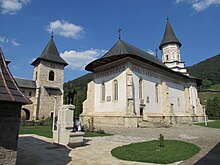Bistrița Monastery
| Bistrița Monastery | |
|---|---|
| Mănăstirea Bistrița | |

Church of the Bistrița Monastery
|
|
| Basic information | |
| Location | Bistrița, Neamț County, Romania |
| Geographic coordinates | 46°57′28″N 26°17′21″E / 46.95778°N 26.28927°ECoordinates: 46°57′28″N 26°17′21″E / 46.95778°N 26.28927°E |
| Affiliation | Eastern Orthodox |
| Country | Romania |
| Ecclesiastical or organizational status | Friary |
| Status | Active |
| Leadership | Metropolitan of Moldavia and Bukovina |
| Patron | Dormition of the Mother of God |
| Architectural description | |
| Architectural type | Classic Moldavian |
| Founder | Alexandru cel Bun |
| Groundbreaking | 1402 |
| Completed | 1407 (first documentary attestation) 1498 (bell tower) 1546 (defense wall) |
| Specifications | |
| Direction of façade | South |
| Length | 40 m |
| Height (max) | 45 m |
The Bistrița Monastery (Romanian: Mănăstirea Bistrița, pronounced [ˈbistrit͡sa]) is a Romanian Orthodox monastery located 8 km west of Piatra Neamț. It was dedicated in 1402, having as original ctitor the Moldavian Voivode Alexandru cel Bun whose remains are buried here.
The church is historically and archaeologically valuable. It shows features of Byzantine architecture, is richly ornamented, with a 15th-century entrance door of fine craftsmanship and detailed frescoes.
The monastery is surrounded by 4 meter high stone walls built during Petru Rareș's reign (1541–1546), the original ones being destroyed in 1538 by Suleiman the Magnificent's army. Also from the same period dates a chapel located north of the monastery. The inner court bell tower had already been erected in 1498 by Ștefan cel Mare. With his extensive restoration of the monastery in 1554, Alexandru Lăpușneanu is also considered to be a ctitor. Thus, the monastery is considered to have been donated by 4 voivodes of the Mușatin dynasty (Alexandru I, Ștefan III, Petru IV, Alexandru Lăpușneanu).
A remarkable item preserved here is the miraculous icon of Saint Anne given as a present to the monastery in 1407-1408 by Voivode Alexandru I's wife, Lady Ana. According to tradition, the icon was given as a "patronage gift" to Lady Ana by empress Jelena, wife of Manuel II Palaiologos, emperor of Constantinople. The icon was restored in the 18th century and in 1853 was placed in a new section, made of carved and gilded wood, of the kliros.
...
Wikipedia
